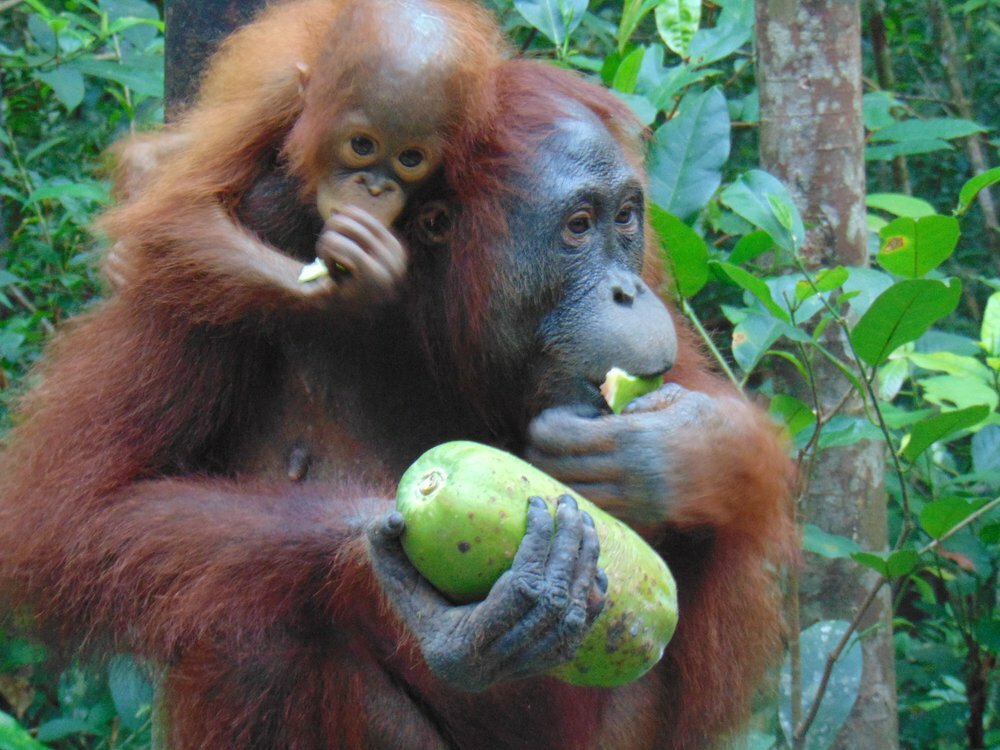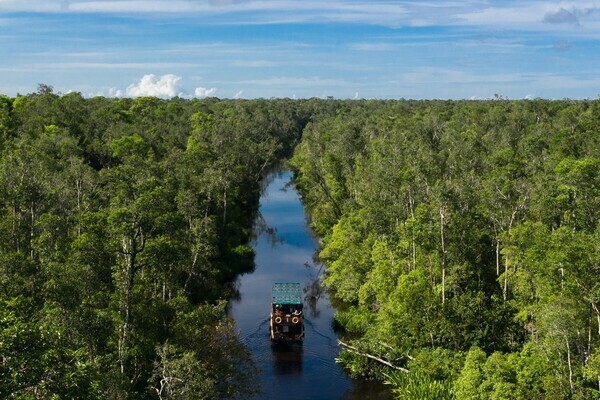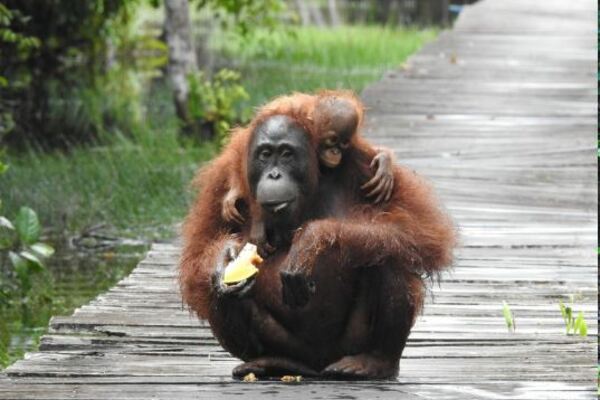
Between 1990 and 2015, 67.9 million acres of forest were lost in Indonesia, with Central Kalimantan experiencing one of the highest rates of deforestation.
The majority of Bornean orangutans are found in Kalimantan. Many live beyond protected areas, straying into places where logging, mining and agriculture (palm oil plantations) are taking over.
The loss of forest habitat is the greatest threat to the orangutan's survival.
All three species are listed as Critically Endangered (Bornean population c100,000; Sumatran population c 13,000; Tapanuli population c800)
Forest Restoration Programme
The Lamandau Wildlife Reserve is a conservation area in western Central Kalimantan, Indonesian Borneo, that was established in 1998 from two former logging concessions. It mainly comprises peat swamp forests that stores more than 36.5 million tonnes of carbon.
The Orangutan Foundation has helped to create and maintain a viable, self-sustaining orangutan population of over 600 individuals in the reserve, as well as increasing the area of prime forest habitat under conservation by 29%.
Orangutans are the largest arboreal mammal. They need vast intact areas to thrive - to give you some idea, two to five individuals need around 250 acres of forest (c 160 football pitches).
Rescued orangutans are released into the reserve, with five different release camps each staffed with an expect local team including a vet.
Labetty with son Leon (pictured) are often seen by the team at Camp Rasak. Labetty was born wild in Lamandau Wildlife Reserve to Lady Di, an orangutan who was rescued and later released at Camp Rasak back in 2006 during the height of Indonesia's deforestation.
Although deforestation has slowed in this part of the world, and the reserve is safe from logging and agriculture, forest fires, exacerbated by climate change, have left their mark.
In El Nino years (which result in a longer, hotter dry season) fires can burn out of control , particularly in peat forest where fire is very challenging to extinguish. Both 2015 and 2019 saw terrible widespread destruction from forest fires, killing wildlife, releasing vast amounts of carbon dioxide and re-shaping the forest habitat.
Last year we partnered with Orangutan Foundation to specifically support their efforts to restore degraded areas of Lamandau Wildlife Reserve.
The first goal was to build an extension to the tree nursery at Vigilant Howe Post – one of four seedling nursery sites.
The new extension will be able to accommodate an extra 14,000 seedlings - doubling Vigilant Howe’s seedling capacity - which will help the team reach its ambitious target to plant out 36,000 saplings this year.
Seedlings are raised in the nursery for around 7 months.
November is the optimum time for planting out and the team then carry out four maintenance treatments (including hoeing and weeding) at intervals over the subsequent two years - this programme gives the seedlings the very best opportunity to grow into a healthy sapling.
We are so delighted to support this project and to be able to contribute to the nursery extension and restoration of Labetty and Leon's forest home.
We look very forward to sharing further updates with you!
Image: Labetty & Leon, Camp Rasak, Lamandau Wildlife Reserve - Orangutan Foundation



Where can I see orangutans?
Indonesian Borneo
Tanjung Puting National Park, Kalimantan in Indonesian Borneo is one of the best places for a forest experience with a chance to see orangutans in the wild. Cruise the river on a special 'Klotok' two-storey wooden houseboat stopping off at Camp Leakey, known throughout the world for its orangutan research; Pondok Tanguy (a rescue/release centre with a feeding platform) and the Pasalat Rainforest station where you can learn about collaborative efforts to conserve the forest here.
Malaysian Borneo
The Malaysian Provinces of Sabah and Sarawak cover the northern areas of Borneo. Sepilok is an area of protected primary rainforest and mangrove on mainland Borneo, and its orangutan rehabilitation centre is known across the world for exceptional conservation work. The reserve protects 19 square miles of dense rainforest, and exists for the rehabilitation of orphaned and injured orang-utans.
In addition, cruising Sabah's longest river, the Kinabatangan River, offers a chance to glimpse wild orangutans along with other wildlife including pygmy elephants, Sumatran rhinos and proboscis monkeys.
The Danum Valley is a 170 square mile reserve protecting swathes of 130 million-year-old rainforest.It's a prime location for seeing an array of incredible wildlife.

